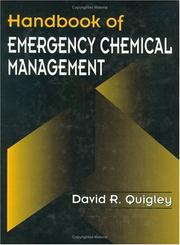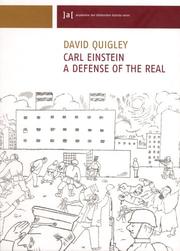| Listing 1 - 6 of 6 |
Sort by
|

ISBN: 0849389089 Year: 1994 Publisher: Boca Raton, FL : CRC Press,
Abstract | Keywords | Export | Availability | Bookmark
 Loading...
Loading...Choose an application
- Reference Manager
- EndNote
- RefWorks (Direct export to RefWorks)
Audio
Year: 2016 Publisher: Vienne: Flip Chart Records,
Abstract | Keywords | Export | Availability | Bookmark
 Loading...
Loading...Choose an application
- Reference Manager
- EndNote
- RefWorks (Direct export to RefWorks)
Cet épisode de l'Histoire de l'art sur disque s'inspire de Carl Einstein (1885-1940), de ses écrits, de sa vie, de son approche de la recherche et surtout de ses attentes extrêmement élevées à l'égard de l'art, toujours à la fois hantées ou tempérées par la conscience des lacunes de l'art. Toutes les interventions musicales sont de David Quigley et Nicholas Hoffman, avec des remerciements particuliers à Dominik Hruza, Misha Stroj et Stephen Mathewson.
Histoire de l'art --- Musique --- Expérimental-essai --- Poésie sonore --- Field recording

ISBN: 9783851600834 3851600835 Year: 2007 Publisher: Vienna: Schlebrügge ,
Abstract | Keywords | Export | Availability | Bookmark
 Loading...
Loading...Choose an application
- Reference Manager
- EndNote
- RefWorks (Direct export to RefWorks)
Carl Einstein (1885-1940) is emerging ever more clearly as one of the most representative and complex figures in the commitments of European artists and intellectuals between the First World War, revolution, avant-garde art, the Spanish Civil War and the rise of National Socialism. With his books "Negro Sculpture" (1915) and "African Sculpture" (1921), Carl Einstein opened the European public to the immanent reality and intensity of this art. He co-edited various journals collaborating with George Grosz and John Heartfield, wrote a very successful Art of the 20th Century and a monograph on Georges Braque. In Paris, he published, with Georges Bataille, the legendary journal "Documents" (1929 - 1930). In an intellectual biography in which an epoch is portrayed, the American writer David Quigley maps out Einstein's various stages and positions in the territory of the political, philosophical and aesthetic arguments for a new art as basis for a new society.
geschiedenis --- cultuurgeschiedenis --- Einstein, Carl --- 20ste eeuw --- Expressionnisme
Book
Year: 2019 Publisher: Northeastern University Press
Abstract | Keywords | Export | Availability | Bookmark
 Loading...
Loading...Choose an application
- Reference Manager
- EndNote
- RefWorks (Direct export to RefWorks)
In a distinguished teaching and writing career that spans half a century, Thomas H. O'Connor has explored in-depth the richly layered history of his native Boston, bringing the city's diverse and fascinating heritage to a wide audience of historians and general readers alike. Now his significant contributions are celebrated in these essays by leading scholars in the field. Originally published by Northeastern University Press in 2004. With a new foreword by Julie de Chantal.
Massachusetts --- Boston (Mass.) --- Politics and government. --- Social conditions. --- History. --- History of the Americas
Book
Year: 2019 Publisher: Northeastern University Press
Abstract | Keywords | Export | Availability | Bookmark
 Loading...
Loading...Choose an application
- Reference Manager
- EndNote
- RefWorks (Direct export to RefWorks)
In a distinguished teaching and writing career that spans half a century, Thomas H. O'Connor has explored in-depth the richly layered history of his native Boston, bringing the city's diverse and fascinating heritage to a wide audience of historians and general readers alike. Now his significant contributions are celebrated in these essays by leading scholars in the field. Originally published by Northeastern University Press in 2004. With a new foreword by Julie de Chantal.
Social conditions. --- Politics and government. --- History of the Americas --- Massachusetts --- Boston (Mass.) --- Boston (Mass.) --- Boston (Mass.) --- Politics and government. --- Social conditions. --- History. --- History of the Americas
Book

ISBN: 1531503969 1531501354 1531501346 Year: 2023 Publisher: Fordham University Press
Abstract | Keywords | Export | Availability | Bookmark
 Loading...
Loading...Choose an application
- Reference Manager
- EndNote
- RefWorks (Direct export to RefWorks)
This book tells the story of how a team of colleagues at Boston College took an unusual approach (working with a design consultancy) to renewing their core and in the process energized administrators, faculty, and students to view liberal arts education as an ongoing process of innovation. It aims to provide insight into what they did and why they did it and to provide a candid account of what has worked and what has not worked. Although all institutions are different, they believe their experiences can provide guidance to others who want to change their general education curriculum or who are being asked to teach core or general education courses in new ways. The book also includes short essays by a number of faculty colleagues who have been teaching in BC's new innovative core courses, providing practical advice about the challenges of trying interdisciplinary teaching, team teaching, project-or problem-based learning, intentional reflection, and other new structures and pedagogies for the first time. It will also address some of the nuts and bolts issues they have encountered when trying to create structures to make curriculum change sustainable over time and to foster ongoing innovation.
| Listing 1 - 6 of 6 |
Sort by
|

 Search
Search Feedback
Feedback About UniCat
About UniCat  Help
Help News
News